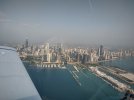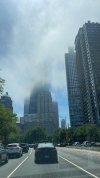As long as you are over the lake, you are good up to 2299’, Midway has new Class C airspace starting at 2300’ and the Bravo starts at 3000’ or 3600’. If over land, the Bravo starts at 1900’ so stay over the lake.
I believe the recommend altitude is 1900’ on the Chicago TAC, so anywhere between 1600’-2000’ is fine, keep in mind there are usually TFR’s over the stadiums that extend out 2-3nm over the lake. Always feels like we keep getting pushed out further and at lower altitudes.
I used to talk to Approach but they always pushed lower altitudes, they clearly don’t like their Bravo starting at 3000’ or 3600’.
Flew this route 2 days ago and with the smog/smoke/haze, you can only see the outlines of the buildings, extremely difficult to see traffic, and the TFR’s pushing you out into the lake, with minimum visibility and the loss of horizon with the lake, can get you disoriented very quickly. Remember your altitude and heading and to fly your instruments if you get disoriented.
Northbound you’ll have Waukegan and Kenosha’s airspace over the lake, both are helpful to transitioning aircraft.
Coming into Chicago area, the pressure is usually lower, high to low look out below, remember to get an updated altimeter setting.
Have fun, take photos and share with us.



